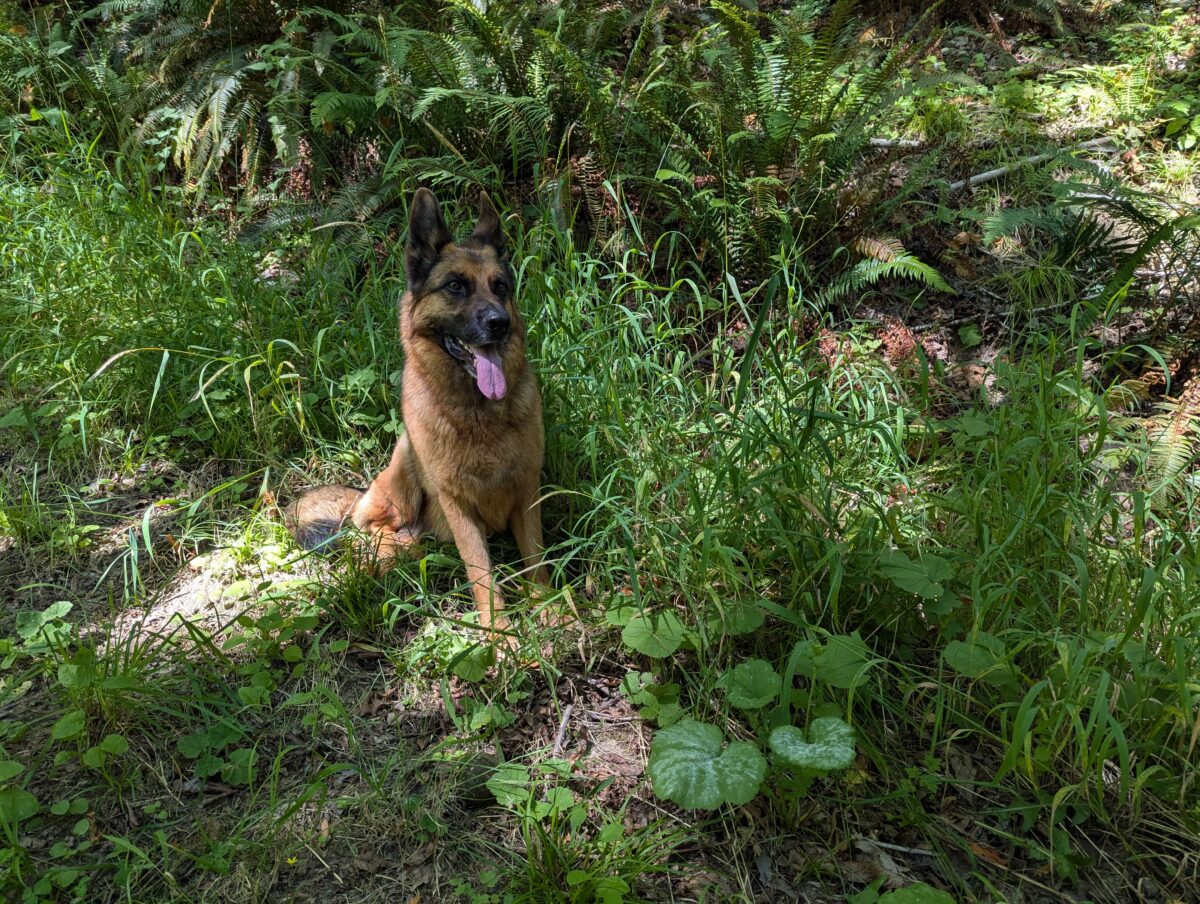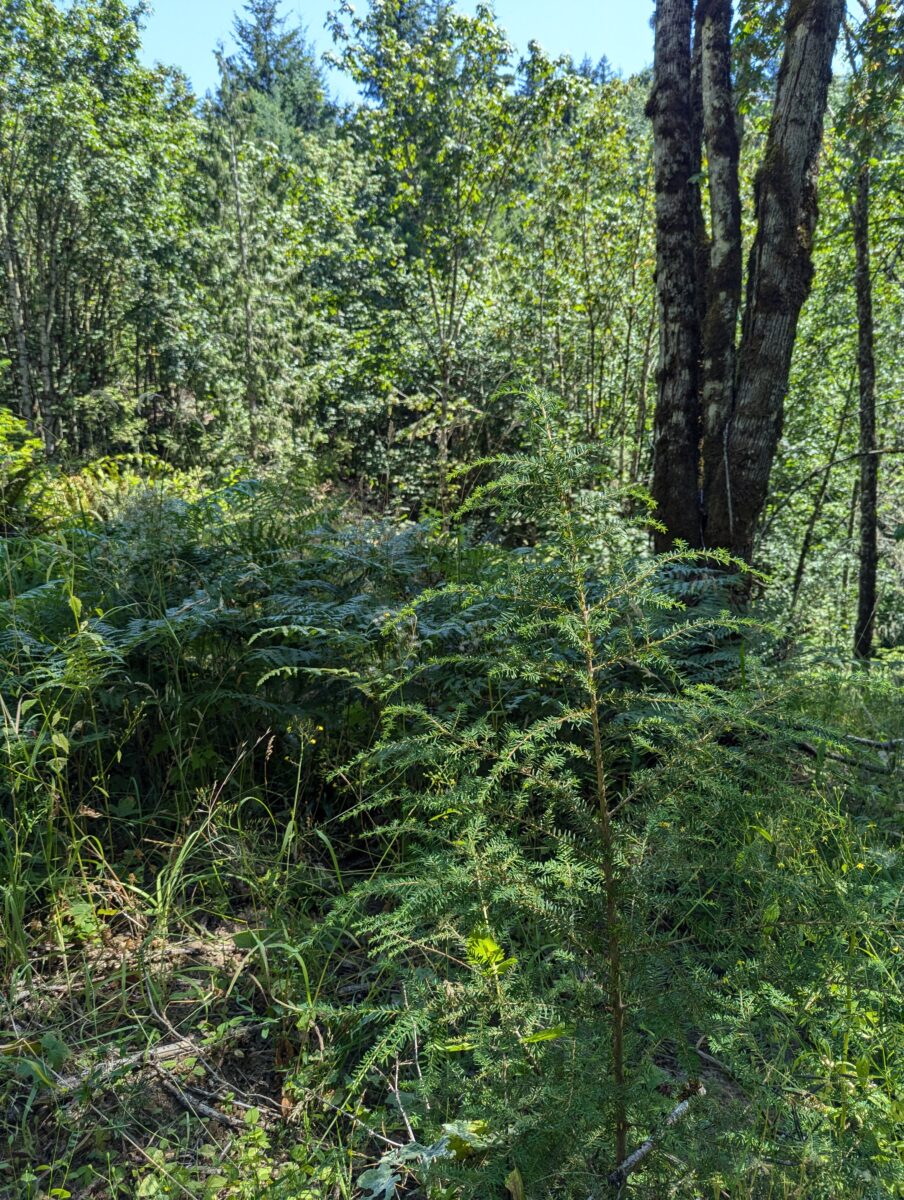by Laura Taylor, forest conservationist
Over the past four years, West Multnomah SWCD has been partnering with Dieter Waiblinger to restore forest health along the headwaters of McCarthy Creek, which is on his property on McNamee Road, in northwest Multnomah County. McCarthy Creek is one of the largest year-round streams in our District and is essential salmonid habitat, especially for Coho and Chinook salmon.
The creek flows from the ridge of the Tualatin Mountains north of Forest Park down to the Multnomah Channel, and is fed by a 2,852-acre watershed. Situated at the very top of the watershed, this property serves an important role in keeping the creek cool and clean at its source. As the creek flows downhill, it connects the upper watershed with other riparianRiparian areas The land alongside a stream, creek, river, or floodplain habitat. This includes the 403-acre McCarthy Creek Forest Natural Area protected by Metro and 22 acres of privately owned riparian and wetland habitat that West Multnomah SWCD has been working to enhance and restore for more than decade.

Rooting out Challenging Plants
The property faced a number of conservation concerns when West Multnomah SWCD began working there in 2020. Young bigleaf maple clumps and a significant amount of Armenian blackberry filled the understory of the forest surrounding the stream. Bigleaf maple is a wonderful native tree, but when people cut it and it re-sprouts from its roots, as happened here, it can grow into clumps of small, weak trunks that are not as healthy or long-lived. This degraded forest was suppressing the establishment of more diverse forest vegetation including longer-lived conifers which are better at providing shade to keep the stream cool for fish and other aquatic wildlife. The large expanses of Armenian blackberry growing beyond the edges of the forest offered some food and habitat for birds and pollinators, but they needed more options to eat and live.
To address these conservation concerns, we had an ambitious goal to replace the Armenian blackberry with more diverse native plants and to thin the forest to allow the space and light needed for diverse conifer trees to establish and thrive. Applying this strategy to the entire 13.5 acres of natural area was cost-prohibitive for both the landowner and our District cost-share program. To cover a significant portion of the project cost, the District applied for and was awarded an Oregon Watershed Enhancement Board (OWEB) small grant in 2021 to fund $15,000 of the work.
Enhancing Biodiversity for Forest Health
With this wind in our sails, we have implemented several strategies and practices to enhance the biodiversity and ecological function of the McCarthy Creek Headwaters. After three years of hard work to remove the Armenian blackberry, we planted native shrubs and seeded native wildflowers such as red flowering currant, oceanspray, and farewell to spring on the sunny slopes above the forest and down in the forest understory. The native seed has established very well, adding flowers for pollinators sooner than it will take for the native shrubs to mature and flower. On some of the open sunny slopes, the initial shrub plantings did not survive well. We are now experimenting with mulching around new plantings to see if this will improve the survival of a second round of plantings.

To enhance forest structure and diversity, we applied a combination of strategies and practices. First, we created some small ¼-acre forest gaps to allow enough light for sun-loving Douglas fir to establish. Second, we removed competing broad-leaf trees that were growing within 15 ft of existing young conifers to give the conifer saplings more space and light to grow. Third, we removed invasive English holly trees. And finally, some more dispersed tree thinningTree thinning Also called “selective harvest,” this is the practice of removing some but not all trees in a forested area. was performed in young hardwood stands where they were growing too densely and were not healthy. Forest thinning was followed by planting hundreds of native conifer trees, including Douglas-fir, western hemlock, western redcedar, and grand fir seedlings; these planted conifers are now growing strong.
Growing Into Maintenance Phase
Applying a diverse suite of restoration strategies is one of the greatest strengths of this project and it has resulted in a more ecologically complex habitat which will support greater biodiversity over time. After closely observing initial outcomes, we adapted to challenges—which will also help this project thrive over time and will help us learn for future restoration projects. Our team and the property owner will need to perform regular maintenance to keep this project on track—ensuring that the native plants establish well and that weeds remain at minimal levels. With the initial heavy-lifting done, the McCarthy Creek Headwaters is off to a great start toward a more ecologically healthy future.